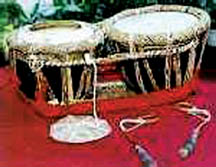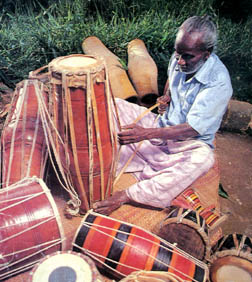
To the beat of drums...
We belong to a nation with a rich culture and heritage. The creations
of our ancestors are simply amazing. In the Heritage Splendour page, we
brought you a lot of information on our ancient architecture. Today, we
tell you about our traditional drums.
You must have seen these drums on various occasions. At avurudu
ceremonies, we use bench drums or thammattam: some of the other drums
are used at the Dalada Maligawa as well. Ancient Sri Lanka had 33
varieties of drums, but today, most of them are confined to names and
only around ten varieties can be found. Pujawaliya, Thupawansaya, and
Dalada Siritha carry descriptions of these drums.

The drums that remain today are Geta Bera (bera is Sinhala for drum),
Yak Bera, Davula, Thammattama, Udakkiya, Dakkiya, Bummadiya, Hand Rabana,
Bench Rabana and Dandu Beraya. The history of our drums is believed to
go back 2,500 years. Drums, which were originally used for pleasure, and
later for rituals, came to be used at Buddhist temples during the many
ceremonies.
At a later stage, drums were also used as a means of communication.
The Davula, Thammattama and Bench Rabana have an important place in
matters of communication. Some of these uses were: Ana Bera - to inform
the people about orders from the King, Vada Bera - drums played when a
criminal is taken for beheading, Mala Bera - drums used in a funeral
procession and Rana Bera - drums used by the army when going out to meet
the enemy.

The Geta Bera is the main drum used to accompany dances in the
Kandyan or Hill Country tradition and is also known as the wedding drum.
This is indispensable for Kandyan dances. This drum is double-headed,
barrel-shaped and turned out of Ehela, Kohomba or Kos wood.
The drum tapers(becomes gradually thinner towards the ends); on the
right side, the opening is covered with the skin of a monkey, while the
opening on the left side is covered with a cattle skin. The strings that
are used to tighten the sides are from a deerskin. This drum is played
by hand.
The Yak Bera is referred to by many names, among which are Ruhunu
Bera, Devol Bera and Ghoskaya. This drum normally accompanies dances
from the low country, especially mask (devil) dancing connected with
rituals and the Kolam folk plays. The drum is turned out of wood from
the Kohomba, Ehela, Kitul or Milla trees. This is a cylindrical drum,
fairly long and is played on both sides with hands. The openings on the
two sides of the drum are covered with the stomach lining of a cow.

The strings used to tighten the sides are from cattle skin. The
Davula is used in most Buddhist ceremonies all over the island. This
drum is from Sabaragamuwa and was used as a companion drum in the past,
to keep strict time with the beat. This is cylindrical, but much shorter
than the Yak Bera. An important feature of this drum is that one side is
played with the hand while the other side is played with a stick. The
sides are covered with cattle skin and the tightening is done with a
string made especially for the purpose.
The Thammattama is also referred to as the Twin Drum. This drum is
played with two sticks. The two drums are of different sizes and while
the right one produces a louder sound, the left one produces a looser
sound. Only the topside of this drum is covered, either with the skin of
a cow or a buffalo. The wood used is Kos, Kohomba or Milla. The special
sticks used to play the drums come from a creeper known as Kirindi.
This is not all about drums. At the beginning of this article, we
told you that there are ten varieties of drums. We'll feature them all
in a future Heritage Splendour page. So keep reading!
Compiled by Janani Amarasekara |


